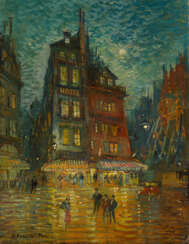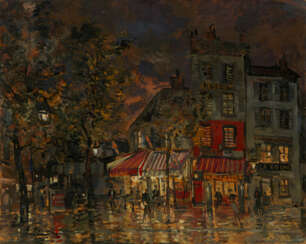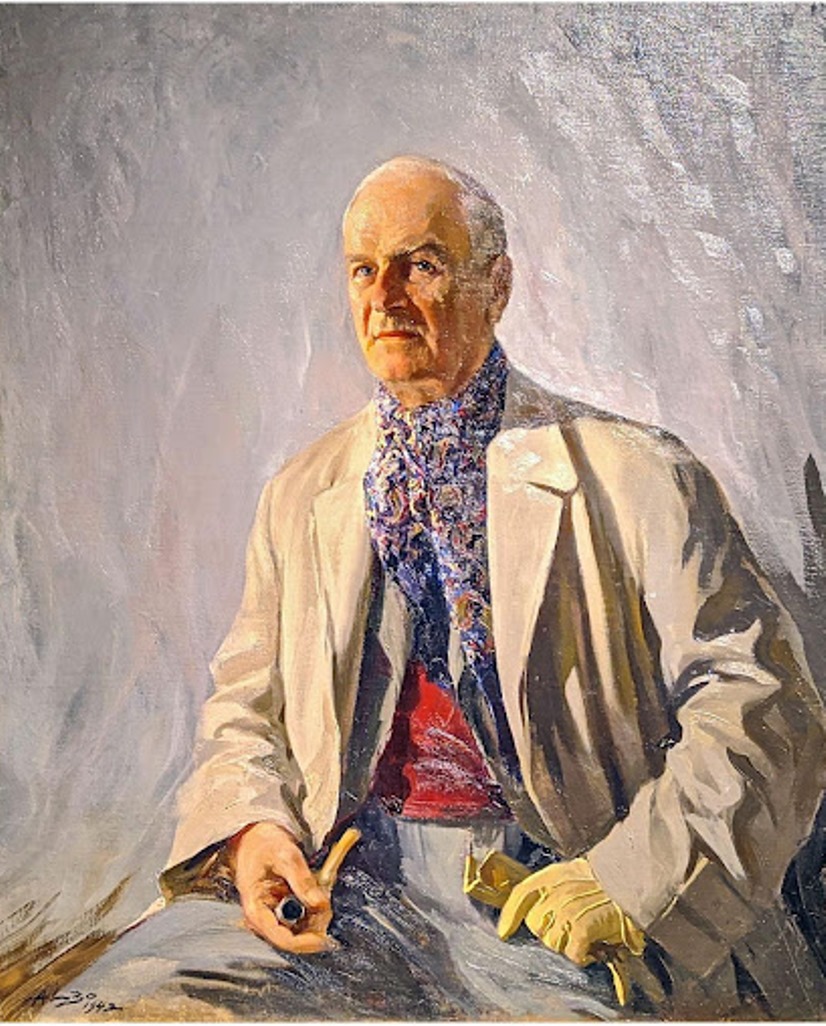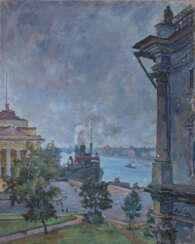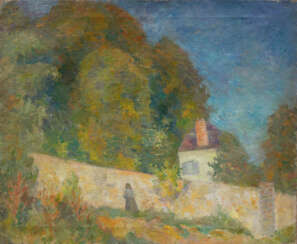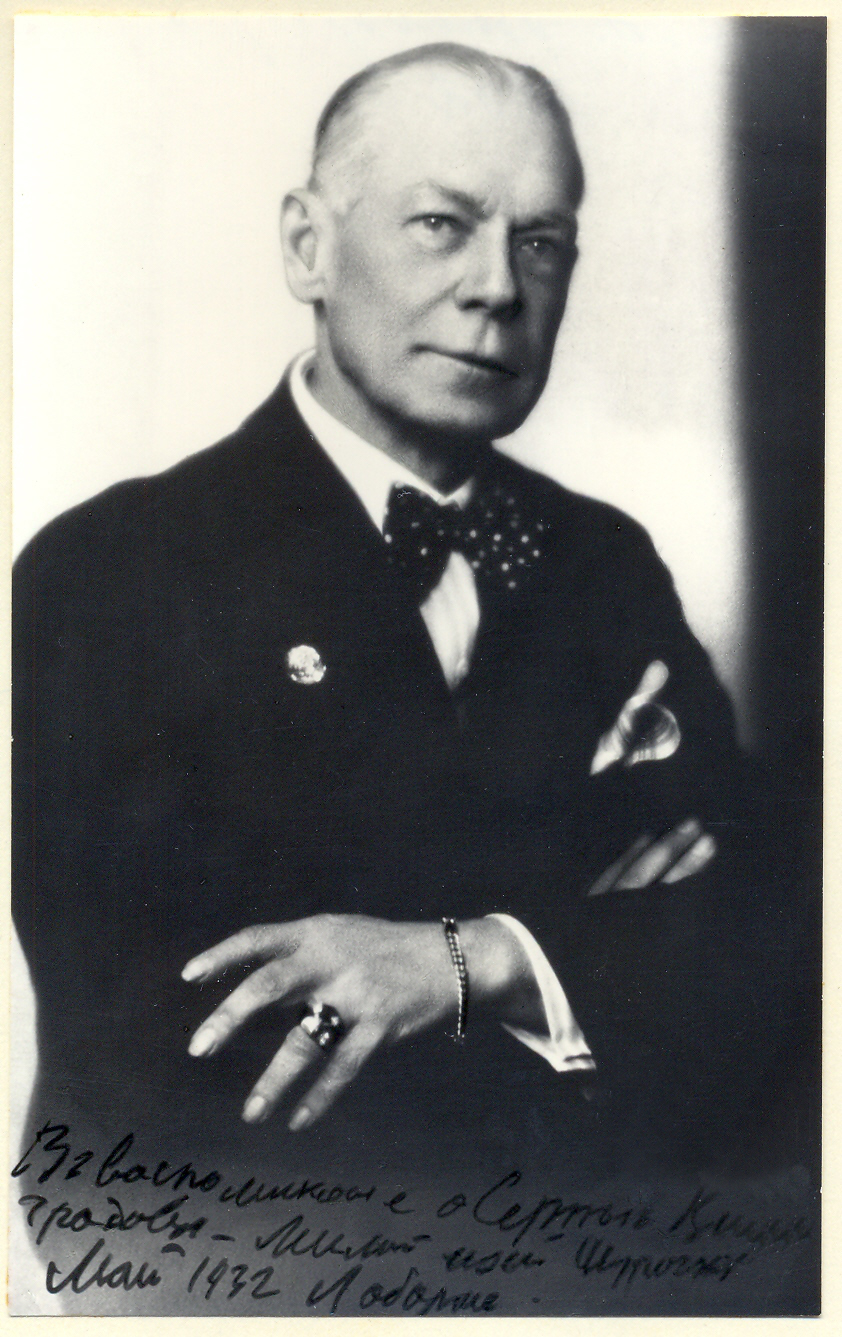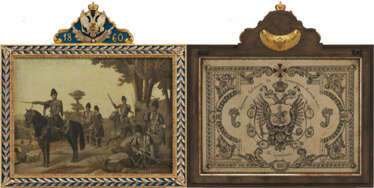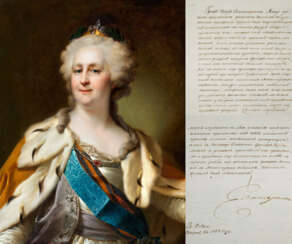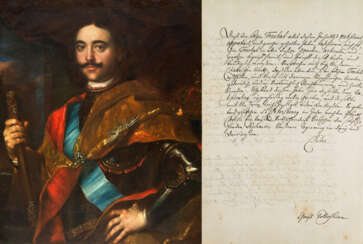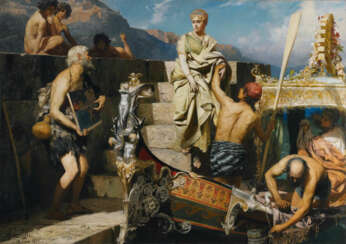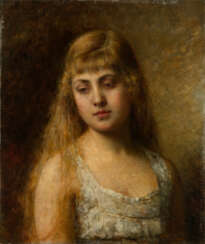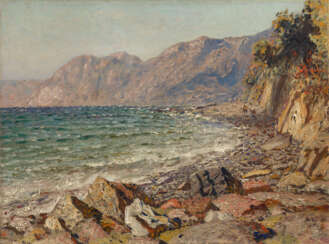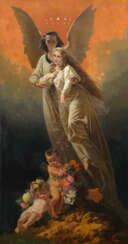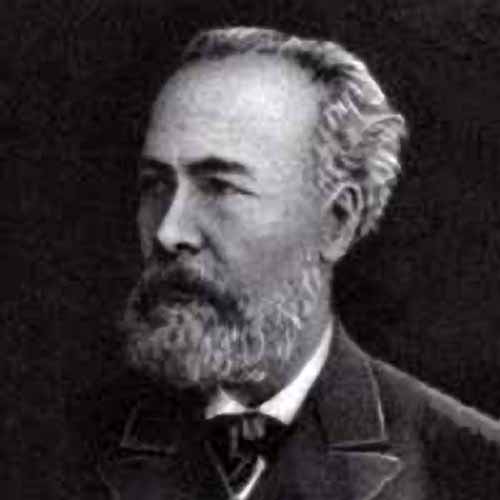важное русское искусство
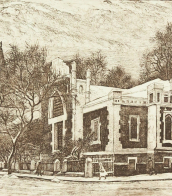
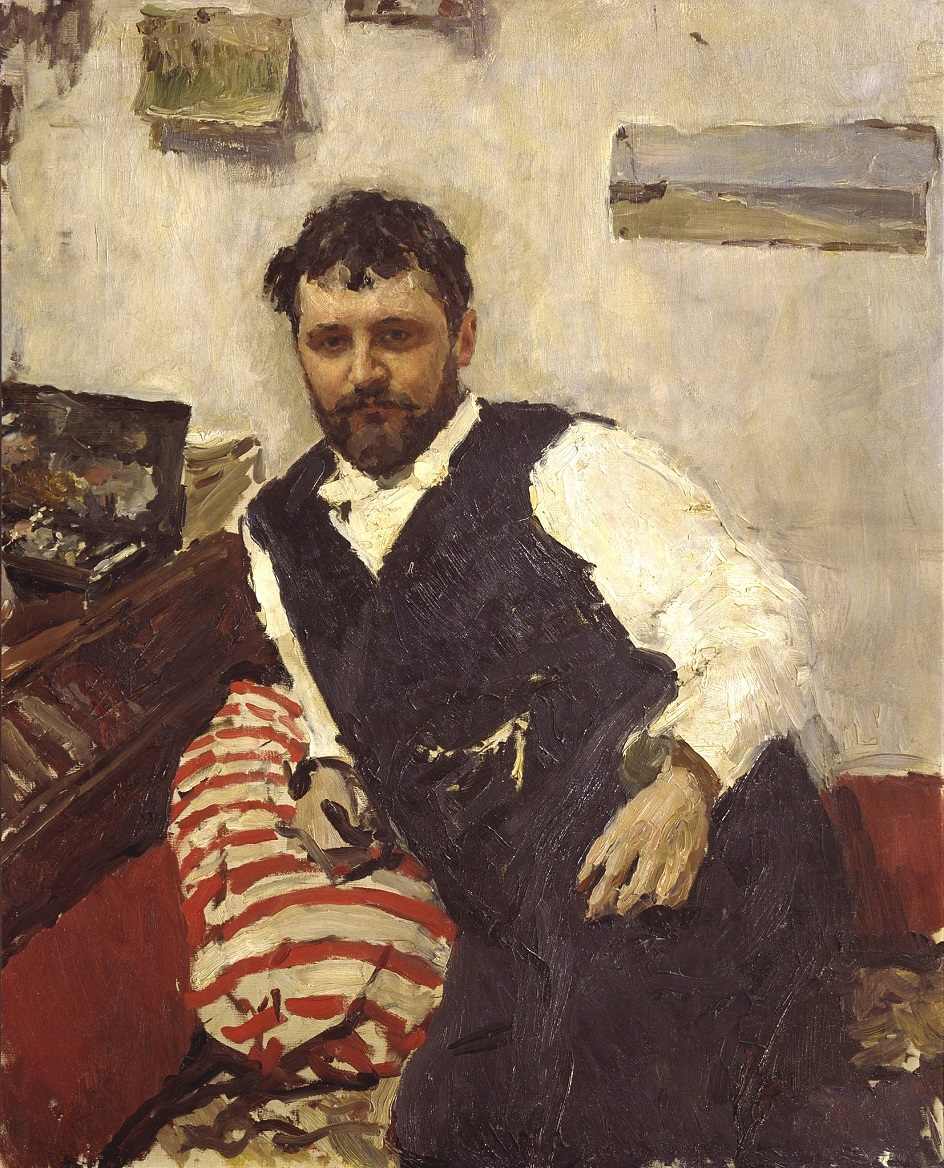
Konstantin Alekseyevich Korovin (Russian: Константи́н Алексе́евич Коро́вин) was a Russian artist and stage designer, renowned for his pivotal role in the transition from Russian Realism to Impressionism. Born in Moscow in 1861, Korovin's artistic journey began at the Moscow School of Painting, Sculpture, and Architecture, where he was heavily influenced by his mentor, Alexei Savrasov. His early work reflected the Realist tradition, but his style evolved after exposure to the vibrant art scenes of Paris and the influence of French Impressionists.
Korovin's contribution to art is marked by his vibrant palette and dynamic brushwork, capturing the transient effects of light and color with a spontaneity that was novel to Russian painting at the time. His works, ranging from lush landscapes and intimate still lifes to vivid portraits, showcase his mastery in evoking mood and atmosphere. Notably, his paintings of the Russian North and scenes of Parisian life have been celebrated for their lively, atmospheric qualities and are held in high esteem in museums and galleries worldwide, including the Tretyakov Gallery in Moscow and the Russian Museum in Saint Petersburg.
Beyond painting, Korovin's legacy includes significant contributions to theater design, where his innovative use of color and lighting brought new dimensions to stage productions in Russia, collaborating closely with the Moscow Art Theatre. His scenic designs for operas and ballets are credited with revolutionizing the visual aspect of Russian theater, making him a pivotal figure in both the visual and performing arts.
For collectors and experts in art and antiques, Korovin's works represent a unique blend of Russian tradition and Western artistic movements, making them highly sought after. His ability to capture the essence of a moment, whether in the tranquil Russian countryside or the bustling streets of Paris, continues to captivate audiences and scholars alike.
To stay informed on new sales and auction events featuring works by Konstantin Alekseyevich Korovin, sign up for our updates. This subscription ensures you're the first to know about valuable opportunities to add to your collection, focusing exclusively on Korovin's art and related events.
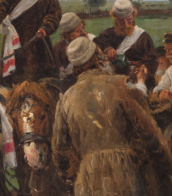

Konstantin Alekseyevich Korovin (Russian: Константи́н Алексе́евич Коро́вин) was a Russian artist and stage designer, renowned for his pivotal role in the transition from Russian Realism to Impressionism. Born in Moscow in 1861, Korovin's artistic journey began at the Moscow School of Painting, Sculpture, and Architecture, where he was heavily influenced by his mentor, Alexei Savrasov. His early work reflected the Realist tradition, but his style evolved after exposure to the vibrant art scenes of Paris and the influence of French Impressionists.
Korovin's contribution to art is marked by his vibrant palette and dynamic brushwork, capturing the transient effects of light and color with a spontaneity that was novel to Russian painting at the time. His works, ranging from lush landscapes and intimate still lifes to vivid portraits, showcase his mastery in evoking mood and atmosphere. Notably, his paintings of the Russian North and scenes of Parisian life have been celebrated for their lively, atmospheric qualities and are held in high esteem in museums and galleries worldwide, including the Tretyakov Gallery in Moscow and the Russian Museum in Saint Petersburg.
Beyond painting, Korovin's legacy includes significant contributions to theater design, where his innovative use of color and lighting brought new dimensions to stage productions in Russia, collaborating closely with the Moscow Art Theatre. His scenic designs for operas and ballets are credited with revolutionizing the visual aspect of Russian theater, making him a pivotal figure in both the visual and performing arts.
For collectors and experts in art and antiques, Korovin's works represent a unique blend of Russian tradition and Western artistic movements, making them highly sought after. His ability to capture the essence of a moment, whether in the tranquil Russian countryside or the bustling streets of Paris, continues to captivate audiences and scholars alike.
To stay informed on new sales and auction events featuring works by Konstantin Alekseyevich Korovin, sign up for our updates. This subscription ensures you're the first to know about valuable opportunities to add to your collection, focusing exclusively on Korovin's art and related events.


Konstantin Alekseyevich Korovin (Russian: Константи́н Алексе́евич Коро́вин) was a Russian artist and stage designer, renowned for his pivotal role in the transition from Russian Realism to Impressionism. Born in Moscow in 1861, Korovin's artistic journey began at the Moscow School of Painting, Sculpture, and Architecture, where he was heavily influenced by his mentor, Alexei Savrasov. His early work reflected the Realist tradition, but his style evolved after exposure to the vibrant art scenes of Paris and the influence of French Impressionists.
Korovin's contribution to art is marked by his vibrant palette and dynamic brushwork, capturing the transient effects of light and color with a spontaneity that was novel to Russian painting at the time. His works, ranging from lush landscapes and intimate still lifes to vivid portraits, showcase his mastery in evoking mood and atmosphere. Notably, his paintings of the Russian North and scenes of Parisian life have been celebrated for their lively, atmospheric qualities and are held in high esteem in museums and galleries worldwide, including the Tretyakov Gallery in Moscow and the Russian Museum in Saint Petersburg.
Beyond painting, Korovin's legacy includes significant contributions to theater design, where his innovative use of color and lighting brought new dimensions to stage productions in Russia, collaborating closely with the Moscow Art Theatre. His scenic designs for operas and ballets are credited with revolutionizing the visual aspect of Russian theater, making him a pivotal figure in both the visual and performing arts.
For collectors and experts in art and antiques, Korovin's works represent a unique blend of Russian tradition and Western artistic movements, making them highly sought after. His ability to capture the essence of a moment, whether in the tranquil Russian countryside or the bustling streets of Paris, continues to captivate audiences and scholars alike.
To stay informed on new sales and auction events featuring works by Konstantin Alekseyevich Korovin, sign up for our updates. This subscription ensures you're the first to know about valuable opportunities to add to your collection, focusing exclusively on Korovin's art and related events.


Konstantin Alekseyevich Korovin (Russian: Константи́н Алексе́евич Коро́вин) was a Russian artist and stage designer, renowned for his pivotal role in the transition from Russian Realism to Impressionism. Born in Moscow in 1861, Korovin's artistic journey began at the Moscow School of Painting, Sculpture, and Architecture, where he was heavily influenced by his mentor, Alexei Savrasov. His early work reflected the Realist tradition, but his style evolved after exposure to the vibrant art scenes of Paris and the influence of French Impressionists.
Korovin's contribution to art is marked by his vibrant palette and dynamic brushwork, capturing the transient effects of light and color with a spontaneity that was novel to Russian painting at the time. His works, ranging from lush landscapes and intimate still lifes to vivid portraits, showcase his mastery in evoking mood and atmosphere. Notably, his paintings of the Russian North and scenes of Parisian life have been celebrated for their lively, atmospheric qualities and are held in high esteem in museums and galleries worldwide, including the Tretyakov Gallery in Moscow and the Russian Museum in Saint Petersburg.
Beyond painting, Korovin's legacy includes significant contributions to theater design, where his innovative use of color and lighting brought new dimensions to stage productions in Russia, collaborating closely with the Moscow Art Theatre. His scenic designs for operas and ballets are credited with revolutionizing the visual aspect of Russian theater, making him a pivotal figure in both the visual and performing arts.
For collectors and experts in art and antiques, Korovin's works represent a unique blend of Russian tradition and Western artistic movements, making them highly sought after. His ability to capture the essence of a moment, whether in the tranquil Russian countryside or the bustling streets of Paris, continues to captivate audiences and scholars alike.
To stay informed on new sales and auction events featuring works by Konstantin Alekseyevich Korovin, sign up for our updates. This subscription ensures you're the first to know about valuable opportunities to add to your collection, focusing exclusively on Korovin's art and related events.

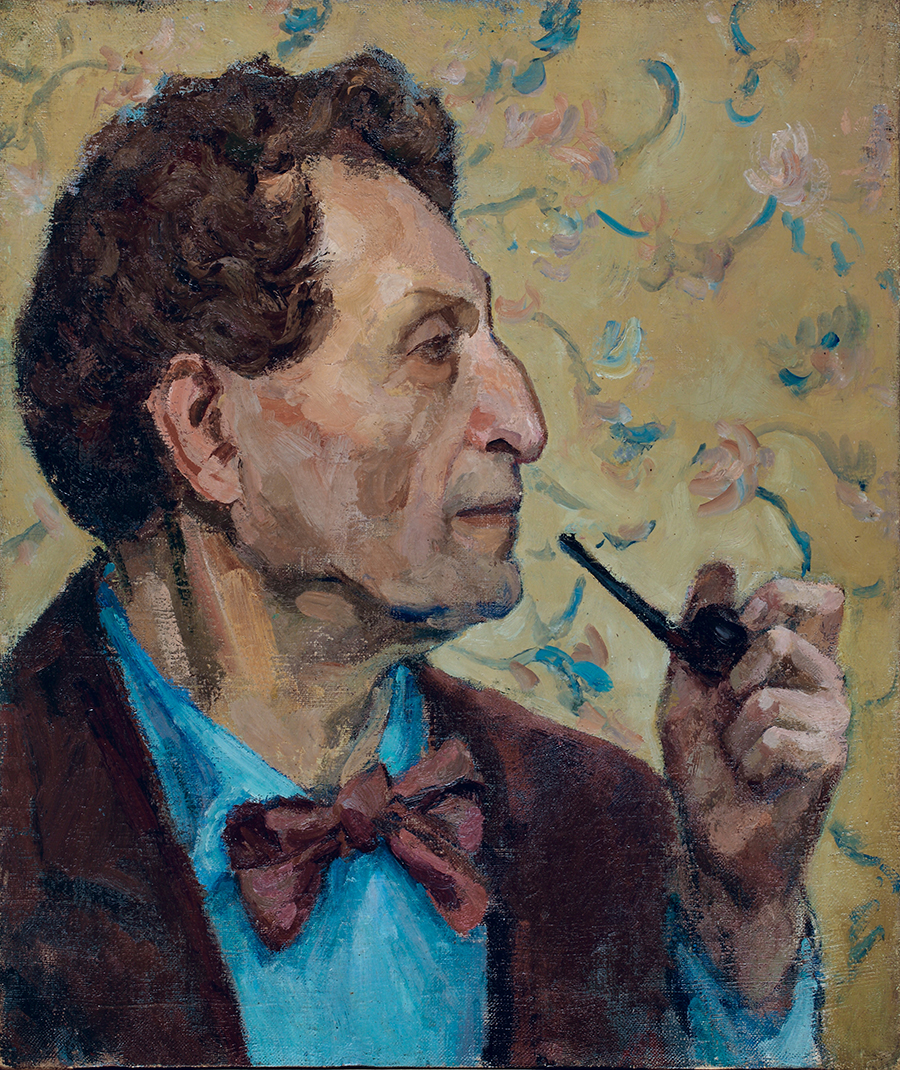
Alexander Alexandrovich Osmerkin (Russian: Александр Александрович Осмёркин) was a Russian avant-garde artist celebrated for his contributions to the development of Russian art in the early 20th century. His journey into the arts was deeply influenced by his childhood exposure to art and literature, which was nurtured by his family and the artistic environment of Moscow, where he later moved to study and work. Osmerkin's early fascination with the works of great artists like Vrubel and his admiration for Pushkin's poetry significantly shaped his artistic development.
Throughout his career, Osmerkin was an influential figure in the Russian avant-garde movement, closely associated with the "Jack of Diamonds" group. His work displayed a vibrant expression of color and form, which he explored alongside notable contemporaries such as Ilya Mashkov and Pyotr Konchalovsky. Osmerkin's versatility spanned painting, graphic art, stage design, and art teaching, leaving a lasting impact on the Soviet art scene. His dedication to art education saw him teaching at prestigious institutions like VKhUTEMAS and the Surikov Institute of Fine Arts in Moscow, influencing a generation of artists.
Despite facing significant challenges during the Stalin era, including accusations of formalism and a ban from teaching and exhibiting, Osmerkin's creative spirit remained undiminished. He continued to produce a vast body of work, including over 700 pieces, ranging from landscapes to still lifes, which are now housed in major Russian museums like the Tretyakov Gallery, the Museum of Fine Arts in Moscow, and the State Russian Museum in St. Petersburg.
For collectors and experts in art and antiques, Alexander Alexandrovich Osmerkin's work represents a critical link in the evolution of Russian avant-garde art, offering insights into the cultural and political landscape of early 20th-century Russia. His legacy continues to inspire and captivate audiences, underscored by his profound influence on his students and the broader artistic community.
For updates on exhibitions and auction events featuring Alexander Alexandrovich Osmerkin's work, sign up for our newsletter. Stay informed on the latest sales and discover the rich history of this pivotal figure in Russian avant-garde art.


Robert Rafailovich Falk (Russian: Роберт Рафаилович Фальк) was a prominent Russian and Soviet avant-garde painter, born in Moscow in 1886. He is celebrated for his innovative contributions to the Jack of Diamonds group, emphasizing expressive volume and angular, saturated color spots in his works. Falk's artistic journey began at the Moscow School of Painting, Sculpture and Architecture, where he studied under notable artists like Konstantin Korovin and Valentin Serov, and further honed his skills in the studios of Konstantin Yuon and Ilya Mashkov.
Falk's style evolved significantly over his career, initially influenced by Paul Cézanne's approach to painting, which emphasized the sculptural form through the layering of paint. His early works are characterized by bright, contrasting colors and expressive contours, capturing physical and tangible elements in landscapes and still lifes. Falk's unique approach also involved a significant degree of form deformation to enhance emotional expressiveness, a technique that set his work apart from his contemporaries.
After spending a decade in Paris from 1928 to 1938, Falk's work underwent a transformation, favoring more subtle and holistic representations. This period was marked by a focus on the rich, musical qualities of color and light, which he applied to both landscapes and portraits. Upon his return to Moscow, Falk found himself increasingly isolated within the Soviet art scene, yet he continued to produce work that resonated with emotional depth and complexity until his death in 1958.
Falk's legacy includes numerous paintings housed in the New Tretyakov Art Museum in Moscow, demonstrating his lasting influence on both Russian and French modern art traditions. Collectors and art enthusiasts are invited to explore the nuanced and evocative works of Robert Rafailovich Falk, a bridge between early 20th-century modernism and the avant-garde movements that followed. Sign up for updates on new product sales and auction events related to Falk to deepen your appreciation and understanding of this pioneering artist's contributions.

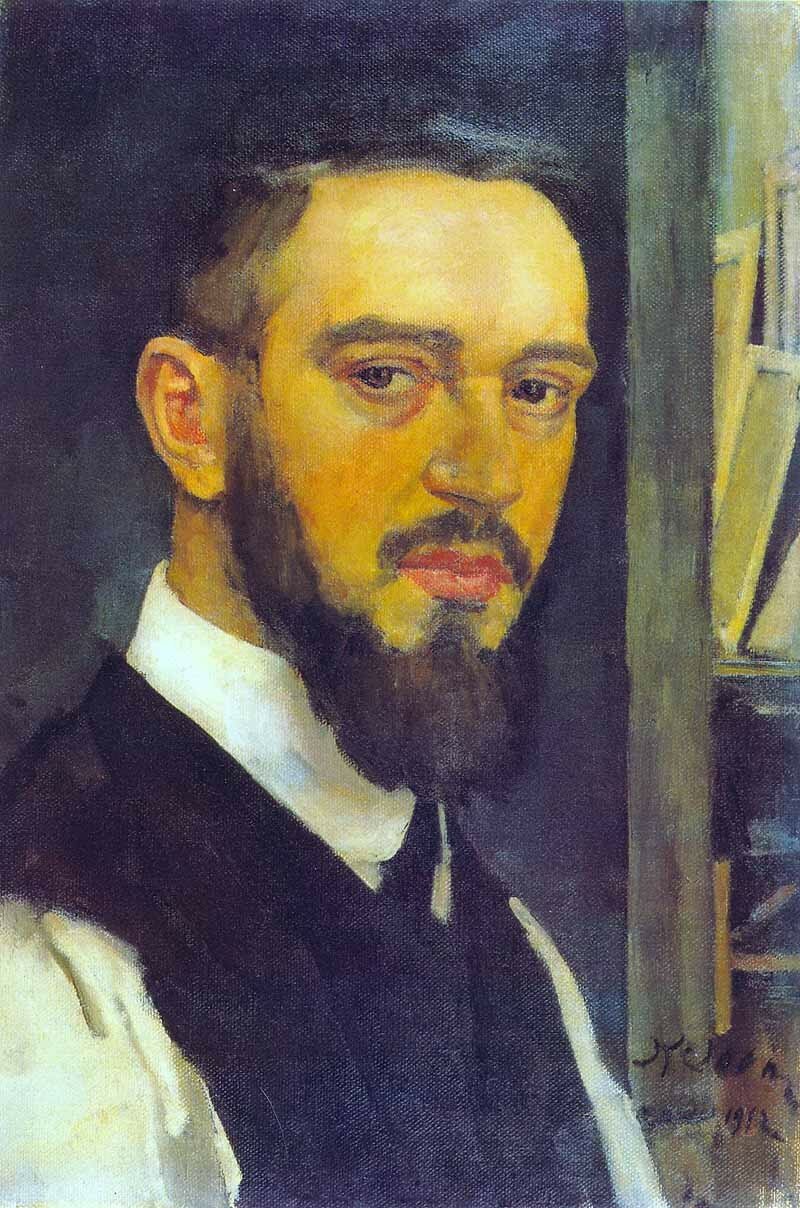
Konstantin Fyodorovich Yuon (Russian: Константи́н Фёдорович Юо́н) was a distinguished Russian artist and painter, celebrated for his multifaceted contributions to the world of art. Born in Moscow, Yuon's work spans painting, stage design, and teaching, making significant impacts across these fields. His artistry is renowned for blending traditional Russian motifs with innovative techniques, illustrating the rich tapestry of Russian culture and history.
Yuon's masterpieces are characterized by their vibrant use of color and light, capturing the essence of Russian landscapes and urban scenes with a unique lyrical quality. His notable works, such as "New Planet" and "The March Sun," showcase his ability to transcend the ordinary, offering viewers a glimpse into the ethereal beauty of everyday life. These pieces not only highlight his technical prowess but also his profound understanding of the emotional and cultural significance of his subjects.
Throughout his career, Yuon's influence extended beyond the canvas, as he nurtured the next generation of artists through his teaching. His dedication to the arts was recognized with prestigious awards, affirming his status as a pillar of the Russian art community. Today, his works are preserved in major museums and galleries, serving as a testament to his enduring legacy in the fields of painting and cultural heritage.
For collectors and experts in art and antiques, the legacy of Konstantin Fyodorovich Yuon offers a fascinating exploration into the evolution of Russian art. His works not only represent significant artistic achievements but also embody the cultural and historical narratives of their time. To stay informed on new product sales and auction events featuring Yuon's work, we invite you to sign up for updates. This subscription will ensure you're always in the loop on opportunities to own a piece of Russian art history.

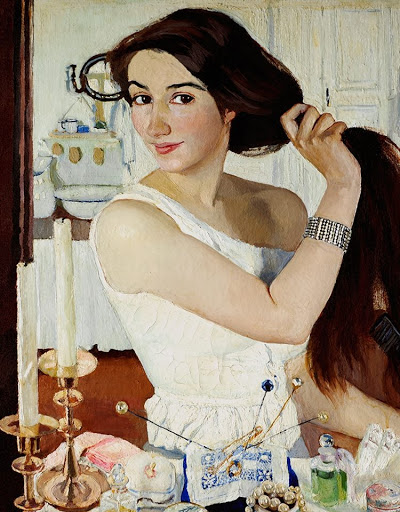
Zinaida Yevgenyevna Serebriakova (Russian: Зинаида Евгеньевна Серебрякова) was a Russian painter known for her lifelike portraits and depictions of rural life, which resonate with warmth and a profound sense of humanity. Born into the distinguished Benois family in 1884, her early life was immersed in art, guided by notable figures like her grandfather, Alexandre Benois, and influenced by her study trips to Italy and under the mentorship of Ilya Repin and Osip Braz. Her marriage to Boris Serebriakov further enriched her artistic environment, enabling her to produce works that captured the simple joys and the intrinsic beauty of her surroundings.
Serebriakova's art gained significant attention with her self-portrait "At the Dressing-Table" (1909) and continued with notable works like "Peasants" (1914–1915) and "Bleaching Cloth" (1917), highlighting her exceptional skill in portraying the Russian countryside and its inhabitants with a blend of grandeur and intimacy. Her ability to imbue her canvases with the spirit of her subjects, whether through the dignified depictions of peasant life or the intimate portrayals of her family, set her apart in the Russian art scene of the early 20th century.
The October Revolution of 1917 marked a turning point in Serebriakova's life, leading to personal tragedies and a shift in her artistic medium due to financial constraints. Despite these challenges, her resilience and dedication to art remained steadfast, evident in her works from this period that include poignant family portraits and explorations of new subjects in the realm of theatre and ballet.
In 1924, Serebriakova moved to Paris, where her art evolved through influences from travels, notably her trips to Morocco, capturing the vibrancy of landscapes and local cultures. Yet, the essence of her work—characterized by a celebration of beauty and life—remained consistent throughout her career. Although separated from her homeland for many years, the recognition of her art in the Soviet Union before her death in 1967 affirmed her lasting impact on Russian and French art.
Zinaida Serebriakova's legacy is a testament to her indomitable spirit and artistic prowess, making her one of the most cherished painters of her time. Her works continue to be celebrated for their technical brilliance, emotional depth, and the unique perspective she offered on the beauty of everyday life.
For collectors and experts in art and antiques, Serebriakova's works offer a window into the soul of early 20th-century Russia and France, embodying the universal themes of family, work, and the natural world with unparalleled sensitivity and grace. To stay updated on sales and auction events featuring Zinaida Yevgenyevna Serebriakova's works, signing up for updates is a step toward owning a piece of this exceptional artistic legacy.


Konstantin Alekseyevich Korovin (Russian: Константи́н Алексе́евич Коро́вин) was a Russian artist and stage designer, renowned for his pivotal role in the transition from Russian Realism to Impressionism. Born in Moscow in 1861, Korovin's artistic journey began at the Moscow School of Painting, Sculpture, and Architecture, where he was heavily influenced by his mentor, Alexei Savrasov. His early work reflected the Realist tradition, but his style evolved after exposure to the vibrant art scenes of Paris and the influence of French Impressionists.
Korovin's contribution to art is marked by his vibrant palette and dynamic brushwork, capturing the transient effects of light and color with a spontaneity that was novel to Russian painting at the time. His works, ranging from lush landscapes and intimate still lifes to vivid portraits, showcase his mastery in evoking mood and atmosphere. Notably, his paintings of the Russian North and scenes of Parisian life have been celebrated for their lively, atmospheric qualities and are held in high esteem in museums and galleries worldwide, including the Tretyakov Gallery in Moscow and the Russian Museum in Saint Petersburg.
Beyond painting, Korovin's legacy includes significant contributions to theater design, where his innovative use of color and lighting brought new dimensions to stage productions in Russia, collaborating closely with the Moscow Art Theatre. His scenic designs for operas and ballets are credited with revolutionizing the visual aspect of Russian theater, making him a pivotal figure in both the visual and performing arts.
For collectors and experts in art and antiques, Korovin's works represent a unique blend of Russian tradition and Western artistic movements, making them highly sought after. His ability to capture the essence of a moment, whether in the tranquil Russian countryside or the bustling streets of Paris, continues to captivate audiences and scholars alike.
To stay informed on new sales and auction events featuring works by Konstantin Alekseyevich Korovin, sign up for our updates. This subscription ensures you're the first to know about valuable opportunities to add to your collection, focusing exclusively on Korovin's art and related events.

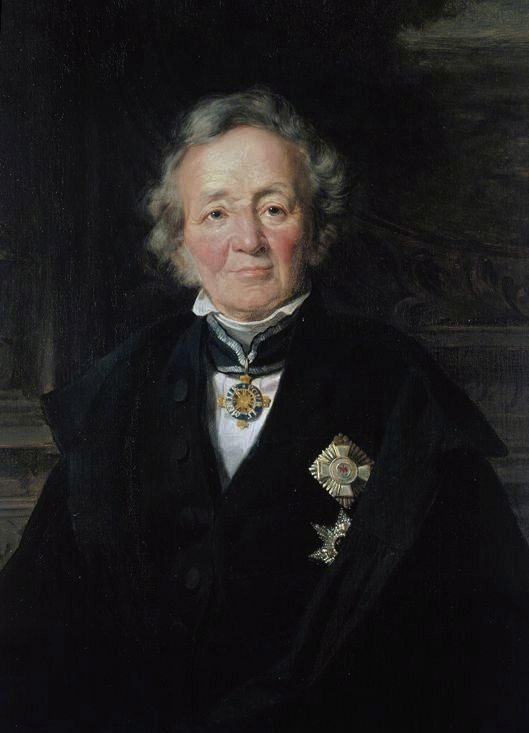
Adolph Jebens was a German painter of the mid-nineteenth century. He is known as a portrait painter and battle-painter.
Jebens moved to Russia in 1844 and became a teacher of painting at the Drawing School of the Imperial Society for the Encouragement of Arts. He created several portraits commissioned by His Imperial Majesty's Cabinet, including a portrait of Emperor Nicholas I. The artist was especially famous for his series of paintings devoted to the Russian army, of which 137 canvases are known. His works are represented in various museums, including the Hermitage, the Russian Museum, imperial palaces and many museums in Germany and Poland.

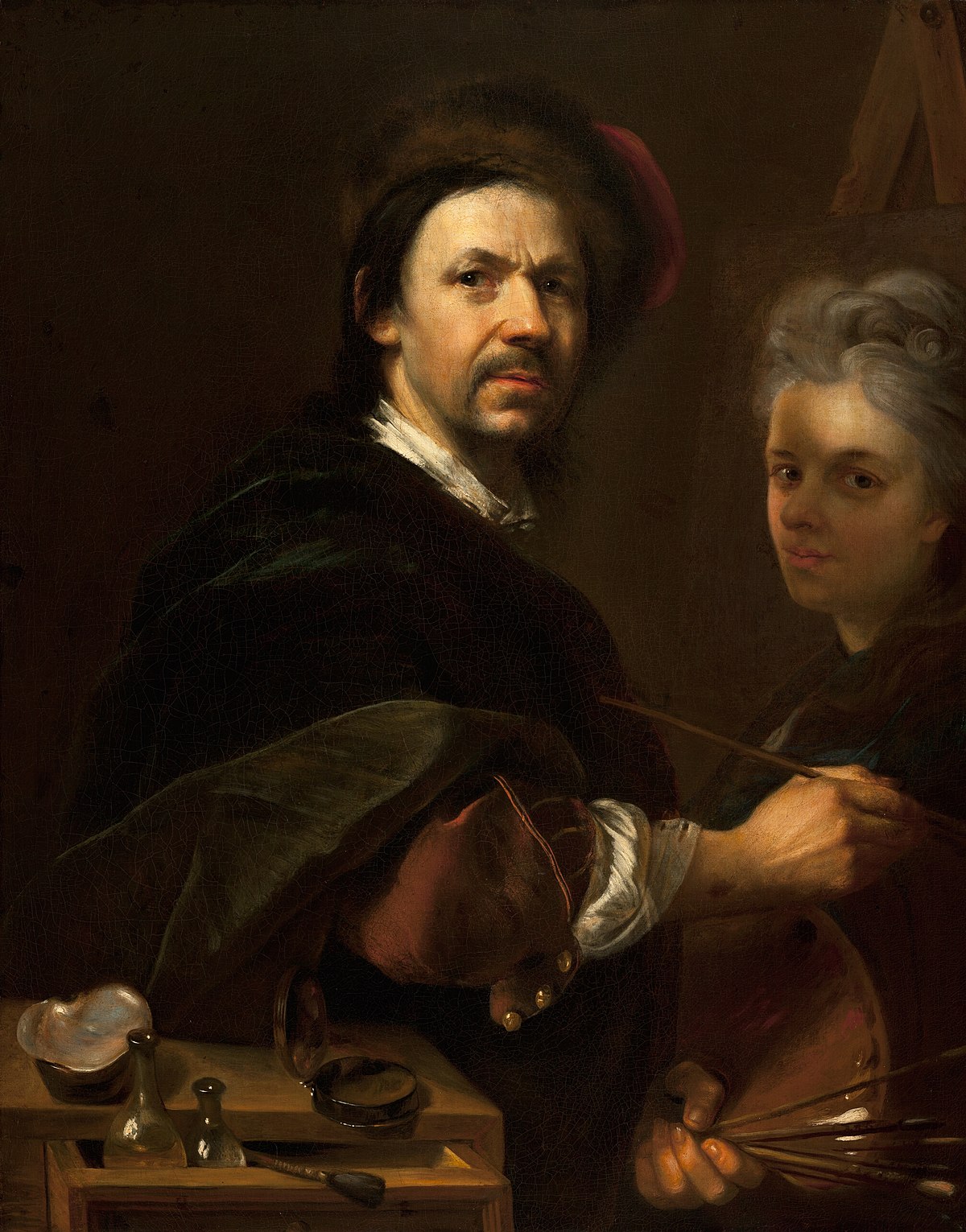
Jan Kupecký was a Slovak painter of the late seventeenth and the first half of the eighteenth century. He is considered one of the greatest portrait painters in Europe of his era. Kupecky also wrote works of historical genre and paintings-allegories.
During his career Jan Kupecky painted more than 10,000 pictures. He left behind a large number of portraits of ordinary people, his colleagues and friends, as well as influential dignitaries and European rulers, as well as dozens of self-portraits.
Numerous works by the artist are now preserved in museums throughout Europe, and the largest collection of his works is in Bratislava, the capital of Slovakia.

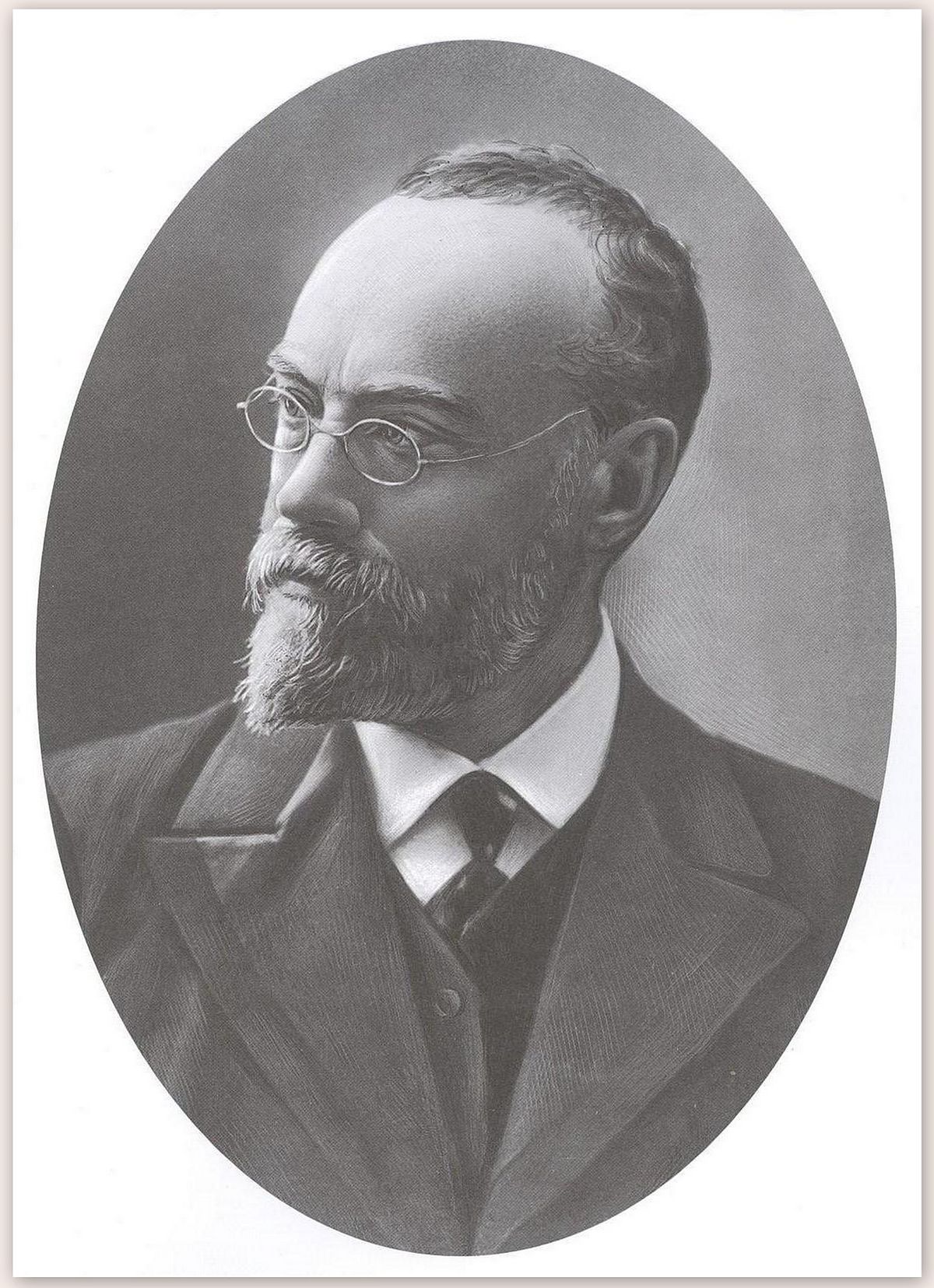
Nikolay Nikanorovich Dubovskoy (Russian: Николай Никанорович Дубовской) was a distinguished Russian landscape painter, renowned for his significant contributions to the "Landscape of Mood" movement alongside Isaac Levitan. Born into a Don Cossack family in Novocherkassk in 1859, Dubovskoy demonstrated artistic talent from an early age, initially encouraged by his uncle A.V. Pyshkin. Despite his father's initial insistence on a military career, Dubovskoy pursued his passion for art, studying under Mikhail Clodt at the Imperial Academy of Arts and later refusing a conventional academic path to instead exhibit with the Imperial Society for the Encouragement of the Arts. His work, "Winter," gained him early recognition when acquired by the Tretyakov Gallery in 1884.
Dubovskoy's legacy includes several masterpieces, such as "After the Rain," a beautiful example of his mature period that demonstrates the influence of French Impressionism, with its open composition and luminous treatment of light. This piece and others underline his mastery in capturing the nuanced interplay of light and atmosphere, resonating with both the Impressionist and Itinerant movements. Unfortunately, the distribution of his works across various museums after his death and the Soviet Union's collapse has made accessing his complete oeuvre challenging, requiring a journey across multiple countries.
Dubovskoy's contributions to Russian landscape painting and his unique ability to evoke mood and atmosphere in his works have cemented his place among the greats of the art world. His paintings, such as "The Calm Evening," praised as a "poem in gold" by critics, demonstrate his exceptional skill in rendering the delicate interplay of light and color. For those interested in exploring the depths of Russian landscape painting, Nikolay Nikanorovich Dubovskoy's works offer a rich and emotive experience, embodying the spirit of an era and the beauty of the Russian landscape.
To stay updated on sales and auction events featuring works by Nikolay Nikanorovich Dubovskoy, sign up for our updates. This subscription will ensure you're informed about new opportunities to appreciate and acquire pieces by this illustrious artist, focusing solely on relevant product sales and auction events.

Henryк Siemiradzki (Russian: Генрих Ипполитович Семирадский) was a Polish-born Russian painter of the second half of the 19th century. He is known as a master of historical and religious genres. Siemiradzki is most famous for his large-scale paintings on ancient and biblical subjects.
Henryk Siemiradzki was one of the most famous representatives of academism of his time. Despite the criticism of much of the painters in the Russian Empire (particularly the Wanderers), by the late 19th century he had become one of the most respected masters of European classical painting. He was recognized as a full member of the Academies of Arts of Rome (where he spent most of his artistic life), Berlin, Stockholm, Paris and Turin, and at international exhibitions the artist's work constantly received the highest awards.
In addition to painting, the painter spent a lot of time on decorative painting, creating murals and large-scale panels for palaces and temples. In particular, he was one of the authors of the mural of the Cathedral of Christ the Savior in Moscow.
The best masterpieces of Siemiradzki's work are now kept in museums in Russia, Ukraine and Poland.

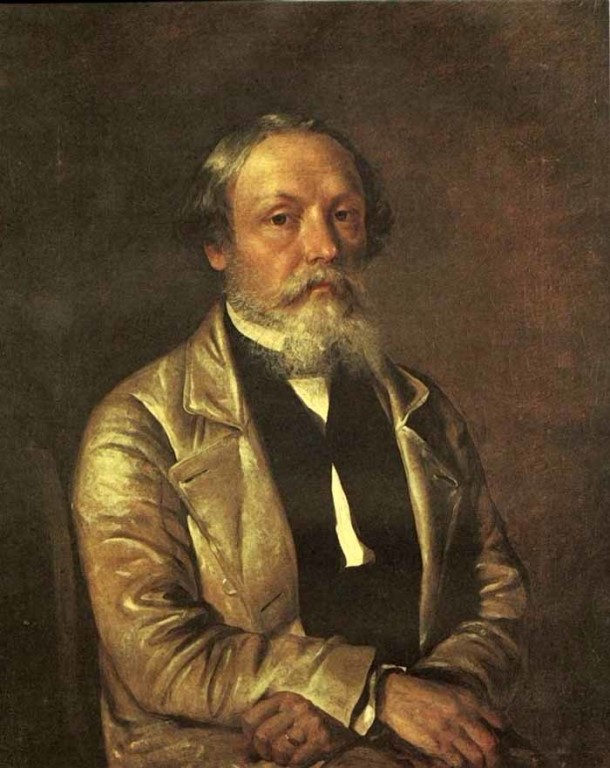
Ivan Fomich Khrutsky (Russian: Иван Фомич Хруцкий) was a Belarusian painter known for his exceptional still-life paintings and portraits. Born in 1810, Khrutsky gained recognition for his detailed and vibrant depictions of flowers, fruits, and everyday objects, showcasing his mastery in capturing light and texture.
Khrutsky's work stands out due to its meticulous attention to detail and rich color palette, which brought a lifelike quality to his paintings. His ability to convey the delicate interplay of light and shadow made his still lifes particularly admired among art collectors and connoisseurs. Aside from still lifes, he also painted portraits, landscapes, and genre scenes, contributing to his versatile artistic repertoire.
One of Khrutsky's notable works, "Flowers and Fruits," exemplifies his skill in creating compositions that are both aesthetically pleasing and technically superb. His paintings are featured in various museums, including the Tretyakov Gallery in Moscow, where art enthusiasts can appreciate his contribution to the world of art.
For those interested in exploring more about Ivan Fomich Khrutsky and staying updated on related auctions and sales, sign up for updates. You'll receive notifications about new product sales and auction events related to this distinguished artist.

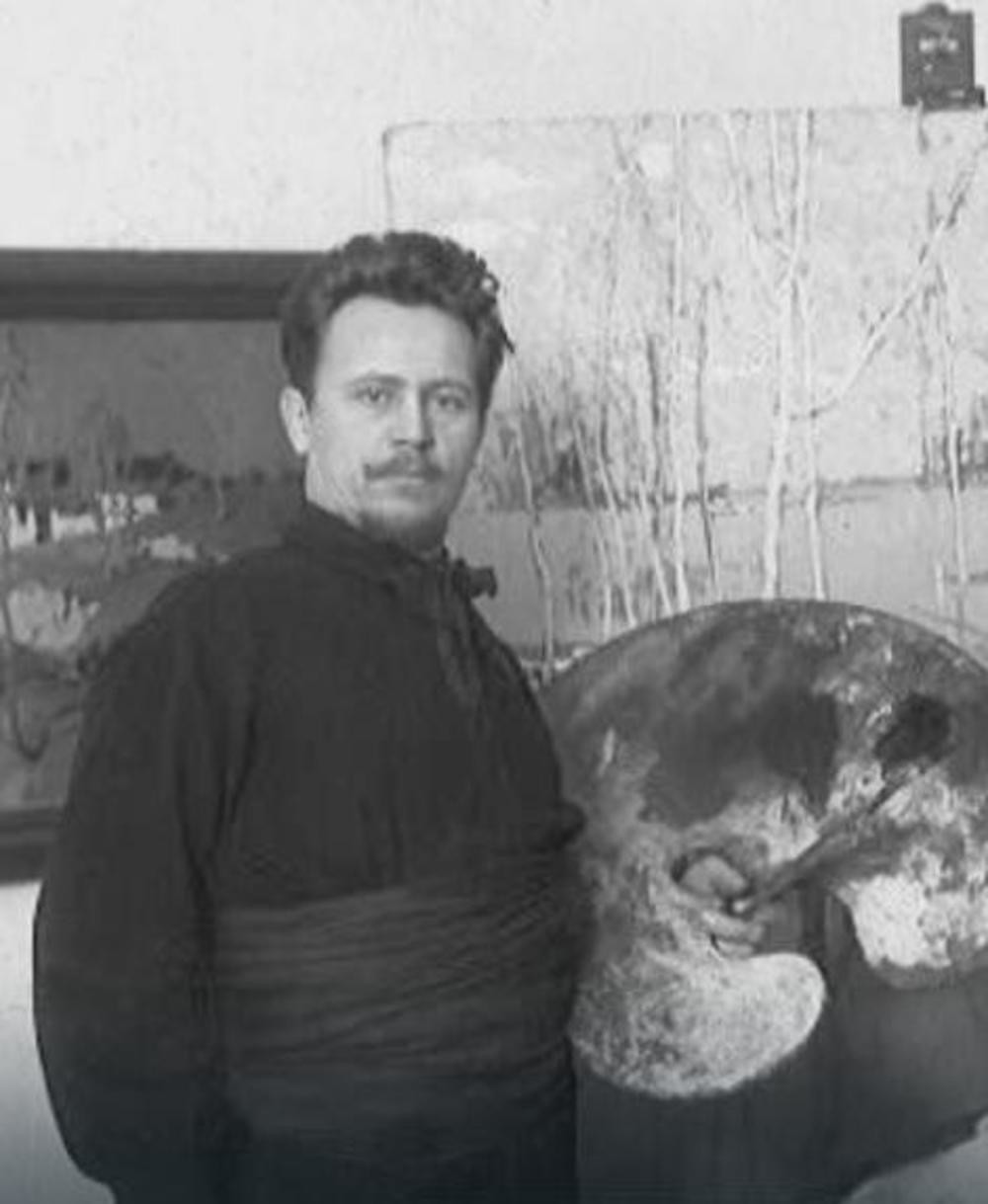
Stepan Fedorovitch Kolesnikoff (Russian: Степан Федорович Колесников) was a Ukrainian realist painter renowned for his exceptional ability to capture the essence of Ukrainian nature and rural life. Born in 1879 in the Russian Empire and passing in 1955 in Belgrade, Yugoslavia, Kolesnikoff's journey began in a humble peasant family. His artistic talent was evident early on, leading him to the Odessa Art School and subsequently, without exams, to the prestigious Imperial Academy of Arts. Here, he was not only a student but also thrived, winning numerous awards for his work.
Kolesnikoff's art is characterized by its focus on the natural awakening of landscapes, melting snows, floods, and the vibrant days of spring. He also had a keen interest in painting domestic scenes filled with people and animals, often using a palette of blues and bright oranges. Despite the rich detail in his paintings, Kolesnikoff rarely highlighted the faces of his subjects, preferring instead to capture the essence of the moment. His work received high praise from Ilya Repin, a leading Russian artist of the time, underscoring Kolesnikoff's significant impact on realism.
After emigrating to the Balkans in 1919 due to the political upheaval in Russia, Kolesnikoff settled in Belgrade where he continued his artistic career. He was warmly welcomed and even participated in state assignments, such as leading restoration works on paintings and frescoes. Kolesnikoff's legacy extends beyond his paintings; he was a respected member of the artistic community, contributing to societies like the "Community of Artists" and "Leonardo da Vinci".
For collectors and experts in art and antiques, Kolesnikoff's work represents a fascinating blend of cultural and historical narratives, imbued with the beauty of Eastern European landscapes and life. His contributions to realism and his unique approach to depicting rural life make his works highly sought after.
To stay updated on exhibitions and auction events featuring Stepan Fedorovitch Kolesnikoff's works, signing up for updates can provide exclusive insights and opportunities to acquire pieces by this remarkable artist.

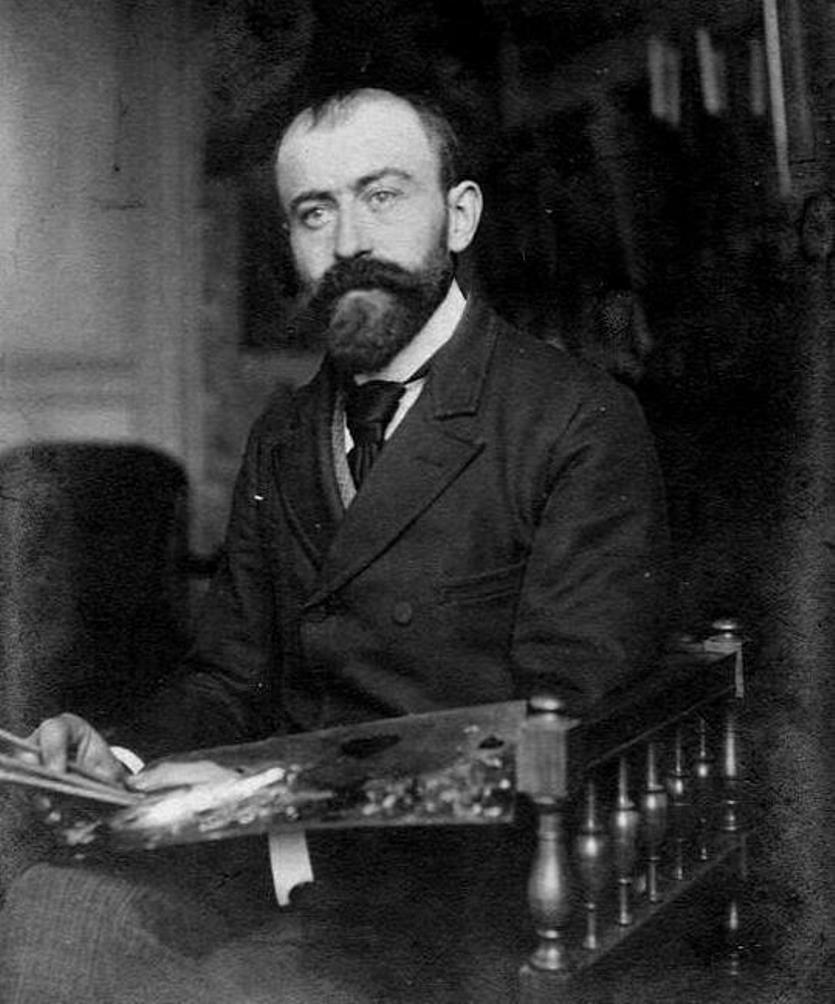
Aleksei Alekseevich Kharlamov (russian: Алексей Алексеевич Харламов) was a Russian artist renowned for his portrait paintings. Born in 1840 in Saratov, Russia, Kharlamov displayed artistic talent from an early age, eventually studying under the guidance of Professor A. T. Markov at the Imperial Academy of Arts. His dedication to art was rewarded with several medals during his academic years, and his piece titled "Baptism of Kiev" earned him a prestigious gold medal in 1866.
Kharlamov spent much of his career in Paris, where he was deeply influenced by Western European artistic movements. His works often featured delicate and finely detailed representations of women and children, capturing the subtleties of expression and mood which became his signature style. Notably, his painting "Young Woman and Child" from 1894 showcases his adept use of light and texture to portray serene domestic scenes, a piece that is currently held in the Bowdoin College Museum of Art.
Throughout his career, Kharlamov was associated with prominent cultural figures such as the novelist Ivan Turgenev, and he participated actively in the Parisian art scene. His portraits were highly sought after, with clients paying substantial sums for his works, reflecting his status as a distinguished portraitist of his time.
For those interested in exploring the works of Aleksei Alekseevich Kharlamov and the rich cultural tapestry of his era, signing up for updates on auctions and events featuring his art can provide valuable insights and opportunities to acquire pieces by this notable artist. Stay informed about the latest sales and exhibitions by subscribing to our newsletter dedicated to Kharlamov’s legacy.

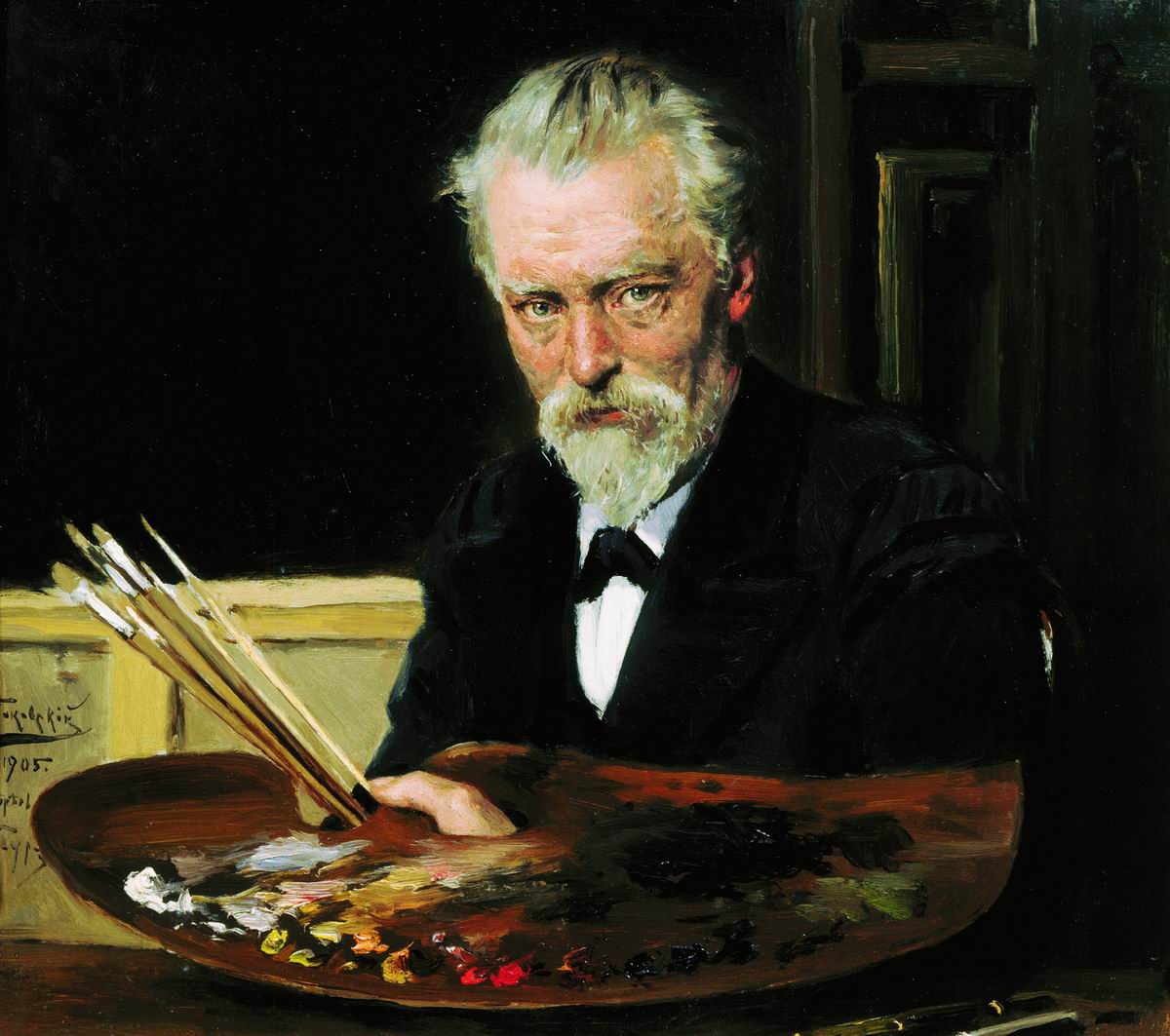
Vladimir Yegorovich Makovsky (Russian: Владимир Егорович Маковский), a distinguished Russian artist born in 1846 in Moscow, was celebrated for his genre paintings that vividly depicted everyday life with a blend of humor and social critique. His father, Yegor Ivanovich Makovsky, co-founded the Moscow School of Painting, Sculpture, and Architecture, where Vladimir later studied and taught, shaping the future of Russian art alongside his artistic family.
Makovsky's work often showcased small-town scenes and common folk, creating narratives that were both endearing and pointedly critical of societal injustices. Noteworthy pieces like "The Grape-juice Seller," "Fruit-Preserving," and "The Congratulator" highlight his skill in capturing the nuances of human expressions and interactions.
Throughout his career, Makovsky remained a pivotal member of the Peredvizhniki (Wanderers), a group dedicated to portraying real-life issues through art. His later works, such as "The Peddler" and "January 9, 1905, on Vasilyev Island," reflect his continued commitment to social themes, depicting historical events with deep empathy for the oppressed.
For art enthusiasts and collectors, Makovsky's works are pivotal in understanding the evolution of Russian realism. His paintings are held in high esteem and are featured in major museums around the world. To stay updated on exhibitions and sales related to Vladimir Yegorovich Makovsky, sign up for our newsletter, focusing exclusively on significant updates from the art world.


Nikolay Nikanorovich Dubovskoy (Russian: Николай Никанорович Дубовской) was a distinguished Russian landscape painter, renowned for his significant contributions to the "Landscape of Mood" movement alongside Isaac Levitan. Born into a Don Cossack family in Novocherkassk in 1859, Dubovskoy demonstrated artistic talent from an early age, initially encouraged by his uncle A.V. Pyshkin. Despite his father's initial insistence on a military career, Dubovskoy pursued his passion for art, studying under Mikhail Clodt at the Imperial Academy of Arts and later refusing a conventional academic path to instead exhibit with the Imperial Society for the Encouragement of the Arts. His work, "Winter," gained him early recognition when acquired by the Tretyakov Gallery in 1884.
Dubovskoy's legacy includes several masterpieces, such as "After the Rain," a beautiful example of his mature period that demonstrates the influence of French Impressionism, with its open composition and luminous treatment of light. This piece and others underline his mastery in capturing the nuanced interplay of light and atmosphere, resonating with both the Impressionist and Itinerant movements. Unfortunately, the distribution of his works across various museums after his death and the Soviet Union's collapse has made accessing his complete oeuvre challenging, requiring a journey across multiple countries.
Dubovskoy's contributions to Russian landscape painting and his unique ability to evoke mood and atmosphere in his works have cemented his place among the greats of the art world. His paintings, such as "The Calm Evening," praised as a "poem in gold" by critics, demonstrate his exceptional skill in rendering the delicate interplay of light and color. For those interested in exploring the depths of Russian landscape painting, Nikolay Nikanorovich Dubovskoy's works offer a rich and emotive experience, embodying the spirit of an era and the beauty of the Russian landscape.
To stay updated on sales and auction events featuring works by Nikolay Nikanorovich Dubovskoy, sign up for our updates. This subscription will ensure you're informed about new opportunities to appreciate and acquire pieces by this illustrious artist, focusing solely on relevant product sales and auction events.

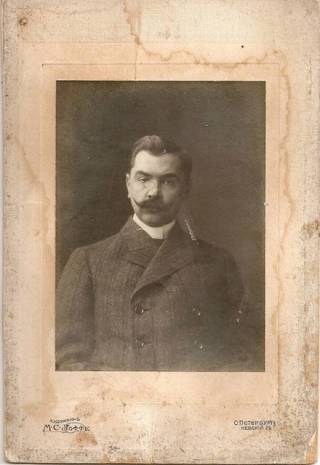
Yevgeny Ivanovich Stolitsa (Russian: Евгений Иванович Столица) was a Russian and Soviet artist of the late 19th century and the first third of the 20th century. He is known as a painter and graphic artist.
Yevgeny Stolitsa is best known as a landscape painter. He also painted portraits, historical and battle paintings. His works are distinguished by a fine transmission of the light and air environment, a free impressionistic style of painting, rich and saturated colors with lots of nuances and shades. According to critics, unpretentious rustic motifs in the artist's portrayal acquired a special poeticism.

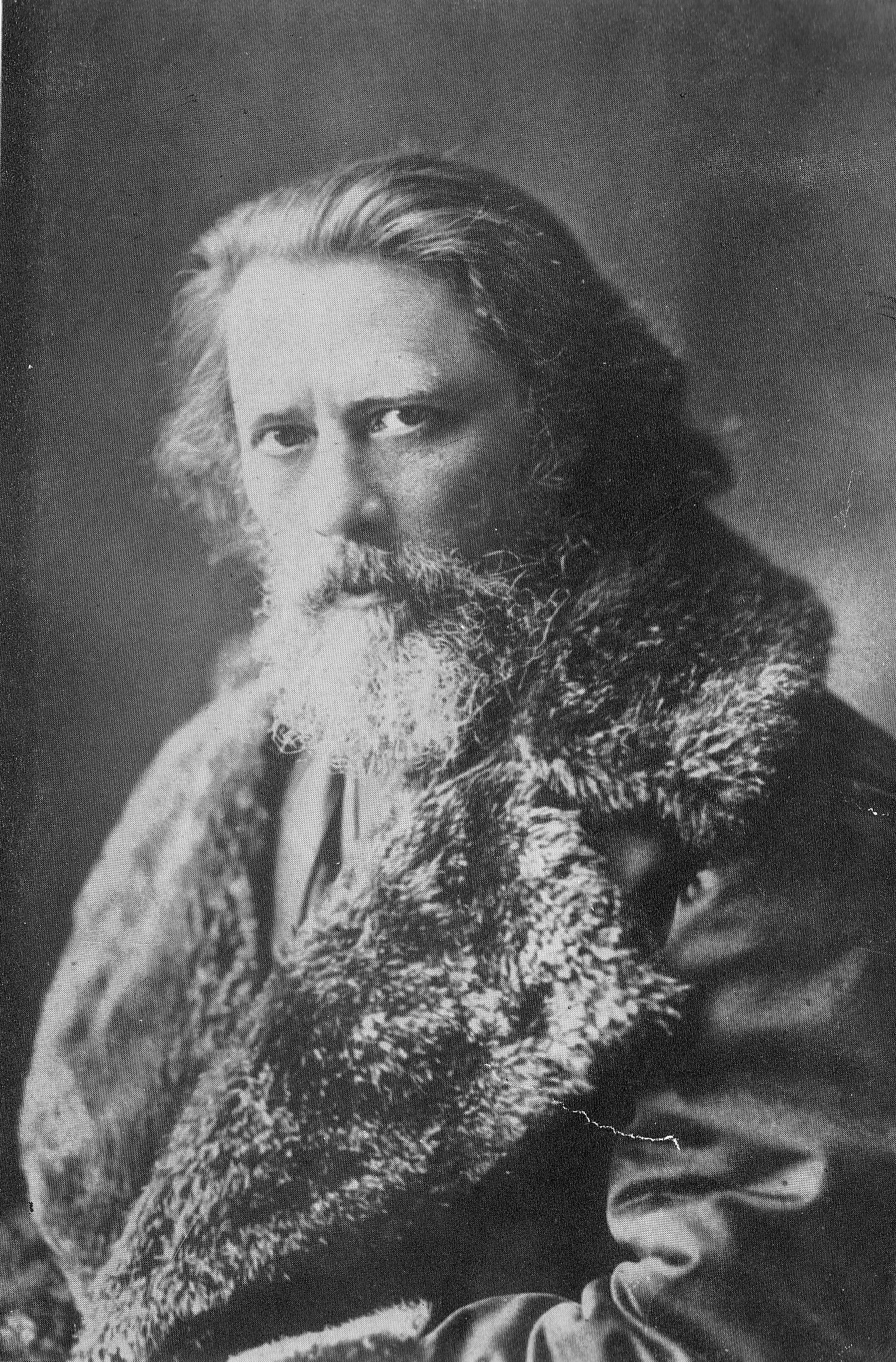

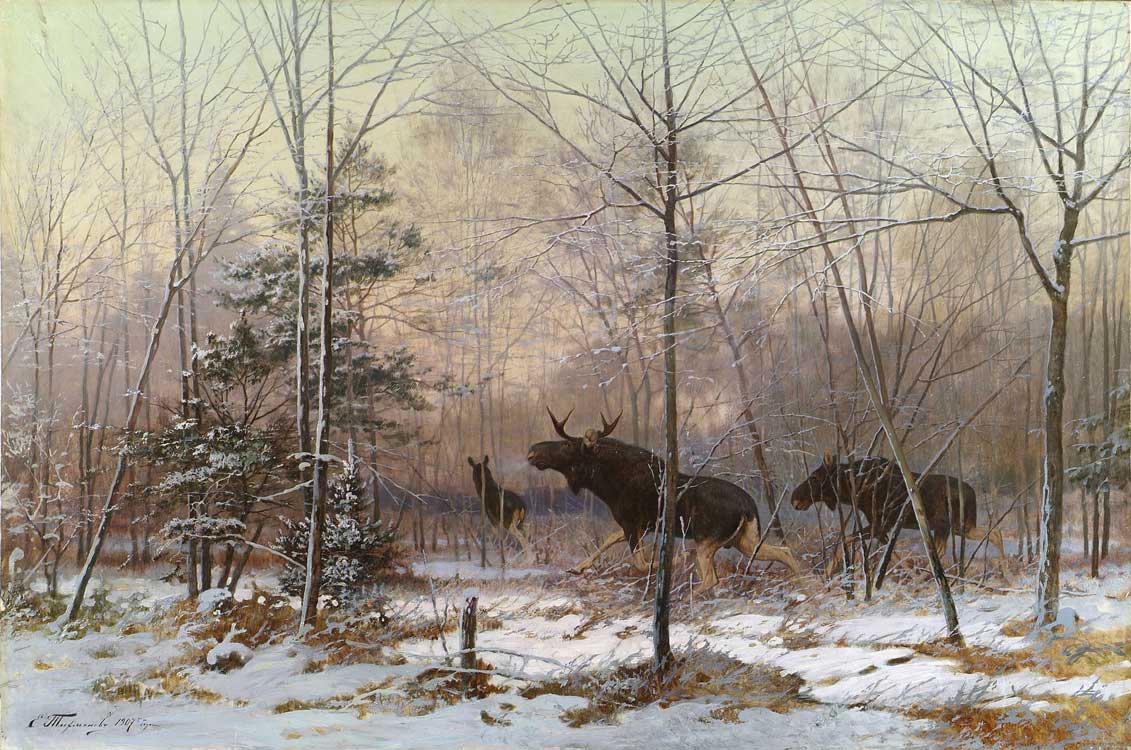
Evgeny Alexandrovich Tikhmenev (Russian: Евгений Александрович Тихменев) was a Russian artist, born in 1869 and passed away in 1934. Renowned for his depictions of natural scenes and hunting expeditions, his works encapsulate the essence of rural Russian life during his time. Tikhmenev's artwork, such as "Before the Hunt," captures moments of anticipation and interaction with nature, often featuring meticulous detail and vibrant settings.
His pieces are cherished in art circles for their historical value and their ability to convey the story of an era when hunting was not only a sport but a significant aspect of rural survival and culture. Notably, Tikhmenev's paintings have been sold at various auctions, with some pieces fetching substantial prices, highlighting their desirability among collectors and art enthusiasts.
For collectors and experts in art and antiques, Tikhmenev's works present a valuable investment, both culturally and financially. To stay updated on new sales and auction events featuring Evgeny Alexandrovich Tikhmenev’s work, signing up for timely updates is recommended, ensuring enthusiasts don't miss out on acquiring a piece of Russian art history.

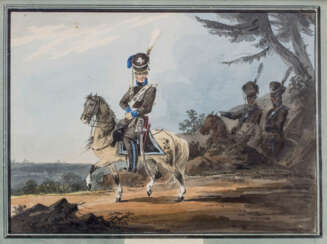

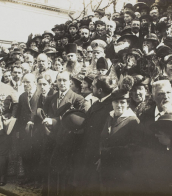
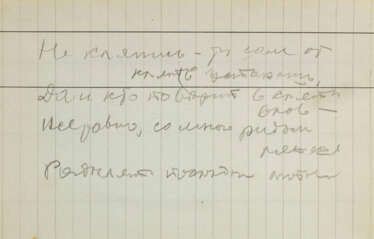

![Выставка: Модель проекта памятника III коммунистическому интернационалу художника В. Татлина: [Афиша]. 1920. 1 л.; 39х27,6 см.](/assets/image/picture_1592478/c7ef7/o26gv3eldobk2lvu9a4o6hjaotjgmgz7dytlehvivxs2vfr4eiqw3qy64iijxuik1625862529jpg__fix_374_244.jpeg)
![Выставка: Модель проекта памятника III коммунистическому интернационалу художника В. Татлина: [Афиша]. 1920. 1 л.; 39х27,6 см.](https://veryimportantlot.com/assets/image/picture_1592478/c7ef7/o26gv3eldobk2lvu9a4o6hjaotjgmgz7dytlehvivxs2vfr4eiqw3qy64iijxuik1625862529jpg__fix_374_244.jpeg)


